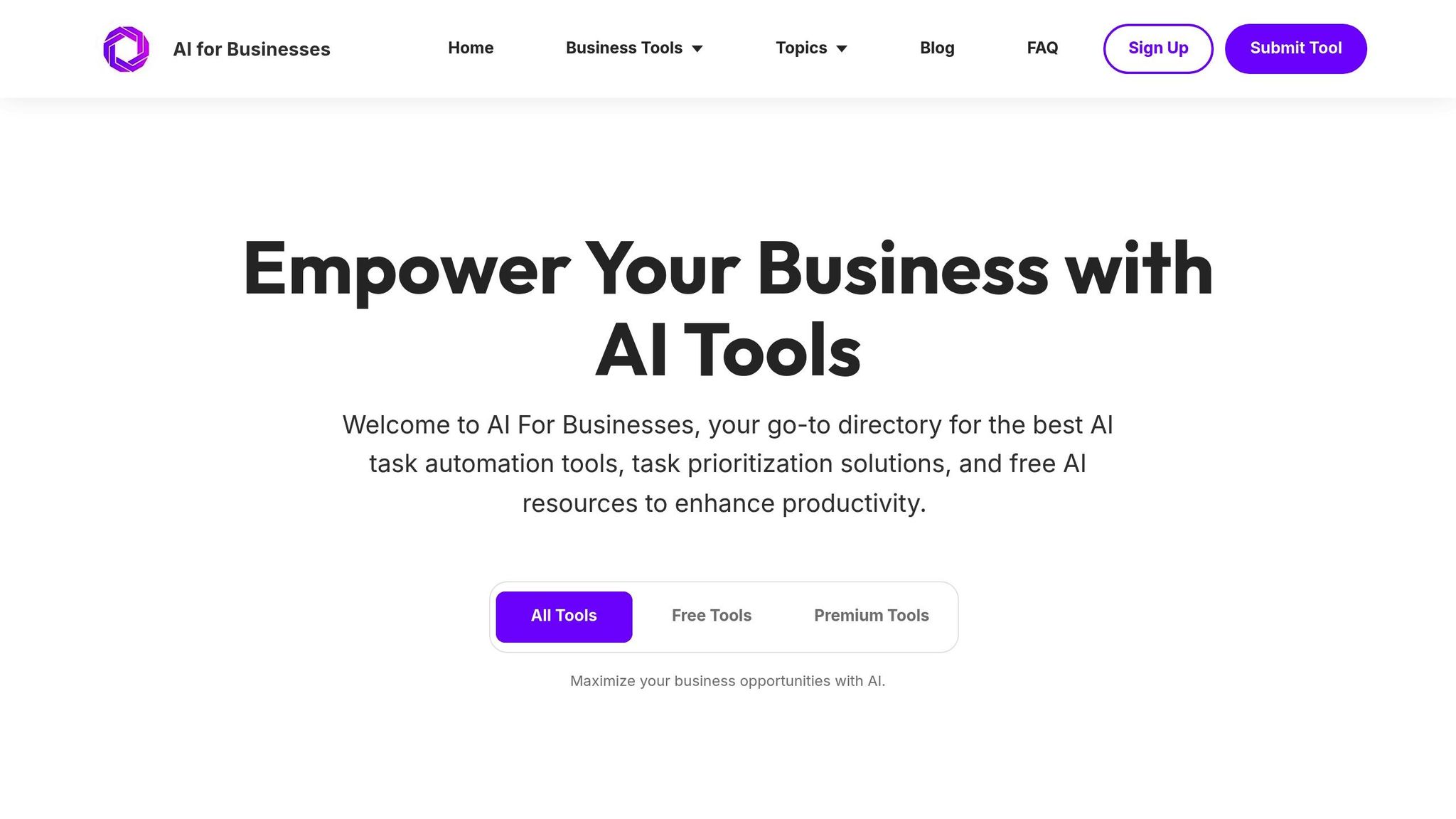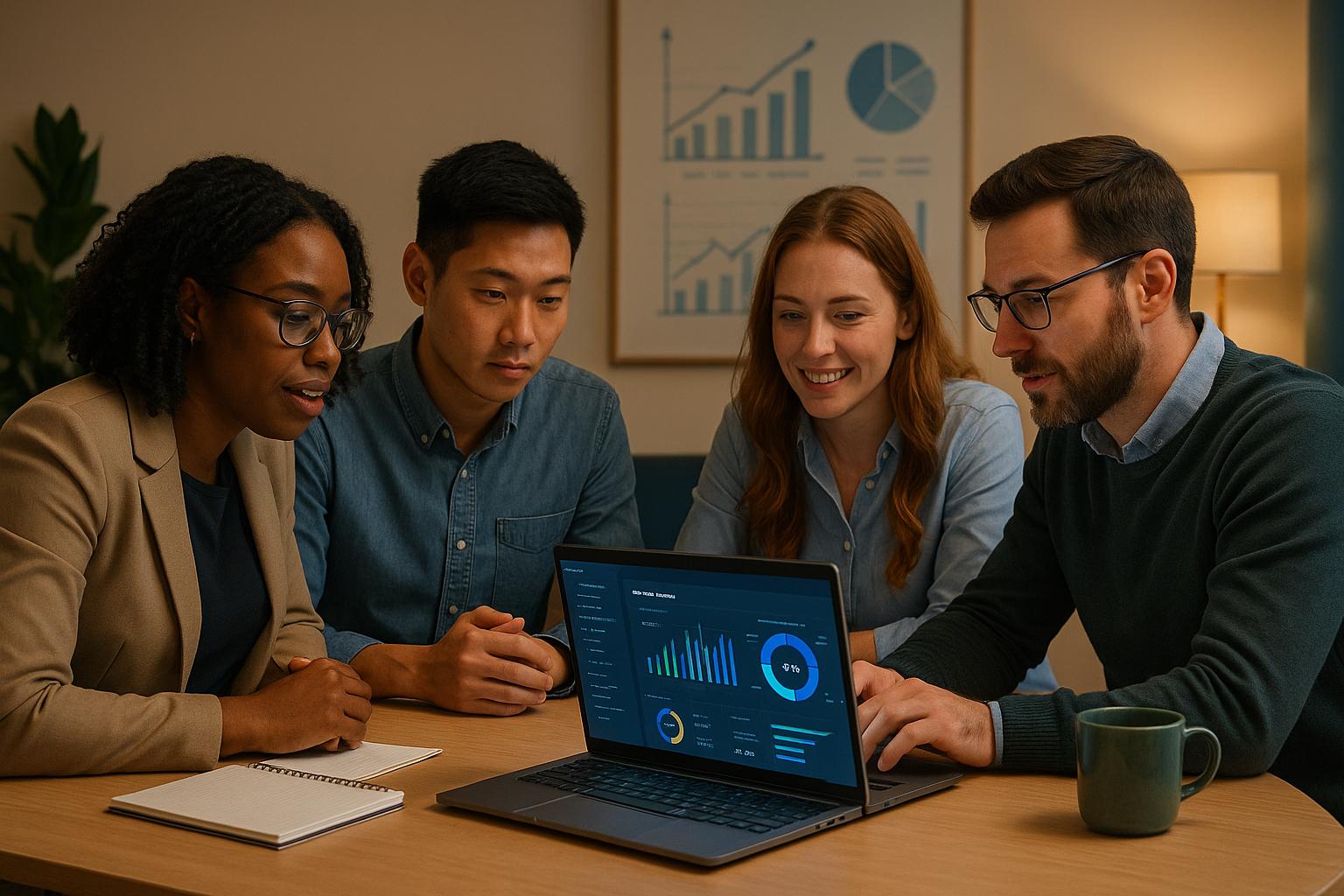AI is transforming how businesses monitor trends on emerging social platforms. By analyzing massive amounts of data in real-time, AI tools can identify patterns, predict viral moments, and provide actionable insights. Here's a quick breakdown of how it works:
- What AI Does: Tracks keywords, hashtags, visuals, and sentiment to detect trends early.
- Why It Matters: New platforms offer untapped audiences and lower competition, making early adoption crucial.
- Key Technologies: Natural Language Processing (NLP) for text analysis, image/video recognition for visual trends, and predictive analytics to forecast trend lifecycles.
- How to Get Started: Define goals, choose platforms, configure tools, and use insights to refine strategies.
AI tools give businesses a competitive edge by spotting opportunities faster and making data-driven decisions. Combining automation with human review ensures accuracy and effectiveness, while regular evaluations keep systems aligned with changing trends.
How AI is Revolutionizing Social Media Marketing Trends You Can't Ignore!
Core AI Technologies for Social Trend Tracking
To make smarter decisions about which tools to use and how to apply them, it’s essential to understand the technology behind AI-powered trend monitoring. Three key technologies form the backbone of most AI-driven social media monitoring systems. Each brings unique strengths to the table, offering businesses deeper insights and actionable strategies.
Natural Language Processing (NLP)
At the heart of effective trend tracking is Natural Language Processing (NLP) - the technology that enables machines to interpret human language in all its complexity. From slang and emojis to cultural references and even sarcasm, NLP deciphers the subtleties of how people communicate online. By breaking down posts, captions, and comments into meaningful data points, it reveals what users are truly thinking and feeling.
Modern NLP goes beyond simple keyword matching. It identifies sentiment, emotion, and context, making it possible to track linguistic shifts - like when new phrases gain popularity or familiar words take on fresh meanings.
One of NLP’s standout abilities is recognizing indirect references. For example, if users repeatedly mention "that new app everyone's talking about" without naming it, NLP systems can connect the dots through context clues and conversation patterns. It also adapts to platform-specific language, understanding the formal tone of LinkedIn, the casual vibe of Twitter, and the emoji-heavy style of TikTok, while identifying when the same trend emerges across these diverse platforms.
Image and Video Recognition
Since visual content dominates many social platforms, image and video recognition has become essential for tracking trends comprehensively. This technology analyzes visuals to detect logos, styles, and patterns that signal emerging trends.
Unlike text-based analysis, computer vision excels at spotting visual trends. It identifies when certain aesthetics become popular, tracks the spread of memes, and detects brand mentions that appear in images or videos rather than text. It also recognizes objects and activities in user-generated content, offering brands a clearer picture of how their products are being used in everyday situations.
Another powerful feature is the ability to analyze facial expressions and body language in videos, providing insights into genuine reactions to products or trends. This is particularly valuable on video-heavy platforms, where user sentiment might not always be expressed in words. Additionally, visual recognition systems can detect patterns of visual consistency - when similar elements appear across posts from different users, it often signals the rise of a new trend.
Predictive Analytics
When it comes to staying ahead of the curve, predictive analytics plays a critical role. By combining historical data with real-time interactions, this technology forecasts which trends are likely to gain traction and which might fade quickly. It helps businesses time their responses to trends for maximum impact.
Predictive analytics identifies early signals of viral content by analyzing interaction rates and tracking how trends migrate across platforms. For instance, when a trend that starts on TikTok begins appearing on Instagram or Twitter, it often indicates broader adoption.
This technology also considers seasonal patterns, major events, and historical data to predict the lifecycle of a trend. It estimates when a trend will peak, how long it might last, and when engagement is likely to drop off. These insights enable businesses to decide whether to invest in a trend or wait for the next opportunity.
Another advantage of predictive analytics is audience analysis. By understanding how trends spread through different demographics, businesses can target their efforts more effectively, avoiding wasted resources on trends that won’t resonate with their audience. What sets modern predictive systems apart is their ability to account for platform-specific factors, such as unique algorithms, user behavior, and content formats. This ensures more precise predictions tailored to each platform a business monitors.
Top AI Tools for Monitoring Trends on New Social Platforms
Now that you’re familiar with the core technologies behind AI, it’s time to explore tools that put these capabilities into action. These technologies fuel platforms designed to deliver insights you can use.
Overview of Leading AI Tools
AI tools for tracking social trends come packed with features like:
- Real-time data updates to visualize trends as they happen.
- Sentiment and engagement analysis across multiple platforms.
- Integration capabilities with existing CRM and analytics systems.
The best tool for you will depend on where your audience spends their time, the depth of insights you need, and how well the tool fits into your broader digital strategy.
How to Choose the Right AI Tool
When picking an AI tool for monitoring social trends, keep these factors in mind:
- Platform Coverage: Make sure the tool tracks the platforms where your audience is most active, including newer, fast-growing networks.
- Budget: Compare pricing models, whether subscription-based or pay-as-you-go.
- Integration: Look for tools that seamlessly connect with your current marketing and analytics systems.
- Scalability: Pick a tool that can handle increasing data volumes and adapt as your needs grow.
- Data Accuracy: Choose platforms that deliver reliable insights and minimize irrelevant data.
- Ease of Use: A simple interface and minimal learning curve are crucial for quick implementation and effective use.
If you’re a small or medium-sized business (SMB) looking for tailored options, the following directory might be a perfect starting point.
AI for Businesses: A Curated Directory

For SMBs, AI for Businesses offers a thoughtfully curated directory of affordable and scalable AI tools. These include options specifically designed for social media monitoring and trend analysis, catering to businesses with limited budgets and technical resources.
What makes this directory stand out is its focus on SMB-friendly solutions. Unlike directories that primarily cater to large enterprises, AI for Businesses emphasizes tools that provide solid value, are easy to learn, and offer flexible pricing. Here’s a breakdown of their pricing plans:
- Basic Plan: Free access to explore available tools.
- Pro Plan: Full access and priority support for $29/month.
- Enterprise Plan: Custom tool integration and dedicated support for larger-scale operations.
This directory simplifies the process of finding the right tools, helping SMBs make informed decisions without the need for extensive technical expertise.
sbb-itb-bec6a7e
Step-by-Step Guide: Setting Up AI Trend Monitoring for Your Business
Setting up AI trend monitoring might sound complex, but with a clear plan, you can have an efficient system delivering actionable insights in just a few weeks. Here’s how to get started.
Define Goals and Select Platforms
Start by clarifying what you want your AI trend monitoring to achieve. Are you aiming to discover viral content opportunities, keep an eye on competitors, or spot emerging customer concerns? Defining your goals will guide every decision, from the tools you choose to the data you track.
Be specific with your objectives. For instance, you could aim to "boost engagement on emerging platforms by 25% within three months" or "identify trending industry topics within 24 hours." These clear targets make it easier to measure success.
Next, figure out where your audience is spending time. Don’t rely on assumptions - analyze your social media data to confirm where your core demographics are most active. Research which new platforms are gaining popularity among your audience segments.
Consider factors like platform growth, user demographics, and content formats. For example, a B2B business might focus on LinkedIn and Twitter, while a consumer brand might explore TikTok or Instagram. Instead of spreading yourself thin, start with 2-3 platforms that align best with your audience and goals.
With your objectives set and platforms chosen, you’re ready to configure your tools.
Set Up and Configure AI Tools
Once you’ve selected your tools, it’s time to set them up for maximum efficiency. Begin by building keyword lists that extend beyond your brand name and basic industry terms. Include variations, related topics, and phrases your audience frequently uses. For example, a fitness brand might monitor terms like "workout", "fitness journey", "gains", and broader lifestyle keywords such as "wellness" or "healthy living."
Don’t stop at keywords - set up hashtag monitoring as well. Track branded hashtags, competitor hashtags, and trending tags in your industry. Many AI tools let you group related hashtags into clusters, helping you avoid missing important variations.
Fine-tune sentiment thresholds to prioritize what matters most. For instance, you might want immediate alerts for spikes in negative sentiment but prefer daily summaries for neutral mentions. Most tools allow you to customize these settings based on sentiment, volume, or engagement levels.
Use geographic and demographic filters to narrow your focus. If your business serves a specific region, set geographic boundaries. If you target certain age groups, configure filters to zero in on relevant conversations.
Before going all-in, test your setup on a small scale. Run the tool for a week and review the results. If you’re overwhelmed with irrelevant data, refine your keywords. If you’re missing key conversations, expand your terms. This trial phase helps you fine-tune your configuration for better results.
Use AI Insights in Your Strategy
With your tools configured, it’s time to put the insights to use. The data collected by AI tools can help you make smarter, quicker decisions to stay ahead of trends.
Update your content strategy based on what’s trending. For example, if your tool shows that video content about a specific topic is gaining traction, adjust your content calendar to include similar themes.
Leverage AI insights for timing optimization. Instead of relying on generic advice about the "best times to post", use data from your tools to pinpoint when your audience is most active on each platform. Some tools even predict the best posting windows based on past engagement patterns.
Identify micro-influencers with high engagement in your niche. Partnering with these influencers often yields better results than working with larger, less-targeted influencers. Additionally, analyze your competitors’ successful tactics to refine your approach.
AI tools can also help with crisis management. Set alerts for sudden spikes in mentions or shifts in sentiment so you can address potential issues before they escalate. This proactive approach can save your brand from unnecessary PR headaches.
Establish a weekly review process to analyze your insights and make adjustments. Use this time to update ad targeting, tweak content themes, or reallocate your budget toward platforms delivering the best engagement. Regular reviews will help you refine your strategy over time and build confidence in your system.
Best Practices for AI Trend Monitoring
Once your AI tools are set up and integrated into your strategy, maintaining their effectiveness requires consistent effort. These best practices will help you stay on track and ensure compliance while monitoring trends.
Ensure Data Privacy and Compliance
Monitoring social media with AI involves a delicate balance between gathering insights and respecting user privacy. AI tools often process large amounts of public data, which may include personal information, so responsible handling is crucial.
Start by familiarizing yourself with platform-specific policies. Each social media platform has its own rules for data collection and usage. For instance, Twitter's API terms differ significantly from TikTok's guidelines. Regularly review these policies, as they may change over time.
Stay compliant with local data regulations like the California Consumer Privacy Act (CCPA) or General Data Protection Regulation (GDPR), especially if your audience spans multiple regions. These laws often require explicit consent for data processing, even when the data is publicly accessible.
To safeguard user privacy, configure your AI tools to anonymize sensitive information while still capturing key trends. Additionally, establish clear data retention policies. For example, you might retain overall trend data for 12 months but delete individual user information after 30 days. Automating these retention schedules can help you balance analytical needs with privacy requirements.
Transparency is key - document your monitoring practices in a privacy policy. Clearly explain what data you collect, how it’s used, and how long it’s stored. This builds trust with your audience and supports compliance with regulatory standards.
Balance Automation with Human Review
AI tools are excellent at processing vast amounts of data quickly, but they aren’t perfect. Machines can miss subtle nuances that humans might catch, making human oversight essential.
Manually review high-priority automated alerts. For example, if your AI flags a potential crisis or a major opportunity, have a team member verify the context before acting. This approach helps avoid errors, such as misinterpreting sarcasm as a genuine complaint.
Set up clear escalation protocols based on alert levels. Minor sentiment changes might only need a weekly review, while sudden spikes in negative mentions could require immediate human attention. Train your team to recognize when AI findings need deeper investigation.
Before acting on trend predictions, use human judgment to validate the insights. If your AI tool identifies a new trend, have team members manually analyze the underlying conversations to ensure the trend is genuine and not artificially amplified by bots.
Regularly audit your AI tool’s accuracy. For instance, take a random sample of 100 mentions each month and have team members categorize them manually. If the tool’s accuracy falls below 85%, it may be time to retrain the system or adjust its settings. These checks ensure your strategy stays precise and adaptable.
Review Tool Performance Regularly
To keep your AI monitoring system effective, regular evaluations are essential. Business goals evolve, platforms change, and audience behavior shifts - what worked six months ago might not be relevant today.
Tailor your review frequency to your business size and activity patterns. For example, monitor individual post performance and content type analysis daily, while broader metrics like follower growth can be assessed monthly or annually. This approach helps you stay on top of immediate opportunities while keeping an eye on long-term trends.
Set up real-time alerts for critical events, such as major brand mentions or significant sentiment shifts. If your system fails to flag these, it’s a sign that your configuration needs fine-tuning.
Track response times to trending topics and adjust your alert settings to ensure swift action when needed.
Lastly, conduct periodic, in-depth reviews of your tool’s performance across various platforms and content types. Some tools might excel on text-heavy platforms like Twitter but struggle with visual content on Instagram. Understanding these strengths and weaknesses allows you to allocate resources wisely and identify areas where additional measures might be required.
Conclusion: Using AI for Social Trend Monitoring Success
AI-powered trend monitoring is reshaping how businesses stay ahead on emerging social platforms by providing real-time insights. With tools like natural language processing (NLP), image recognition, and predictive analytics, companies can quickly spot both opportunities and potential risks across various platforms.
Success in this area depends on selecting the right mix of AI tools that match your business goals and the platforms you focus on. Whether you're tracking visual trends or conversational shifts, this approach helps businesses act on fleeting opportunities before they pass.
To make the most of these tools, integrating human oversight is crucial. Combining automated AI systems with human judgment enhances your strategy, ensures data privacy compliance, and allows for the flexibility needed to adjust as platforms evolve. Regularly reviewing performance keeps your monitoring efforts aligned with changing market dynamics.
As new platforms emerge and existing ones roll out fresh features, businesses that excel at AI-driven trend monitoring will gain a competitive edge. With proper setup, consistent maintenance, and strategic use of AI insights, you can respond faster, understand your audience better, and target more precisely. This approach ensures your business stays agile and ready to adapt to new trends as they arise.
For those ready to dive in, these strategies align with broader AI applications discussed earlier. AI for Businesses offers a curated selection of tools tailored for small and medium-sized enterprises (SMEs) and scale-ups, making it easier to find the right solutions for effective trend monitoring and beyond.
FAQs
How can businesses protect data privacy and stay compliant when using AI for tracking trends on social platforms?
To safeguard data privacy and stay compliant with regulations, businesses need to adopt strong data governance practices. This means keeping a detailed inventory of datasets, encrypting sensitive data, and conducting regular audits on how information is used. Securing clear user consent and following privacy laws like GDPR and CCPA are also essential to minimize legal risks.
Regular risk assessments and keeping up with changing privacy laws can add another layer of protection. These actions not only help you meet compliance standards but also foster trust with your audience, ensuring AI tools for trend monitoring are used responsibly.
How do Natural Language Processing, image recognition, and predictive analytics help track trends on social media?
Artificial Intelligence taps into Natural Language Processing (NLP), image recognition, and predictive analytics to monitor social media trends in ways that stand out.
NLP dives into the text - like posts, comments, and hashtags - to figure out what’s trending and gauge public sentiment as it happens. Meanwhile, image recognition focuses on visuals, analyzing photos, videos, and memes to pinpoint popular imagery or visual trends. Then there’s predictive analytics, which digs into historical data to predict what might trend next, giving businesses a chance to prepare for shifts before they fully take off.
With these AI-driven tools working together, businesses gain a comprehensive view of social media trends, unlocking insights that help them stay ahead of the curve.
What should small and medium-sized businesses look for in AI tools to track trends on new social platforms?
Small and medium-sized businesses (SMBs) should consider AI tools designed for social listening, predictive analytics, and sentiment analysis. These features can help businesses spot new trends and understand audience preferences in real-time, giving them a chance to stay ahead in the ever-changing digital space.
When selecting tools, prioritize those that are easy to use and work well with your current social media management platforms. The best solutions will offer actionable insights, like localized content ideas and trend predictions tailored to your audience. By using these capabilities, SMBs can keep a close eye on shifts across emerging social platforms and adapt quickly, ensuring they stay competitive in this fast-paced digital world.


